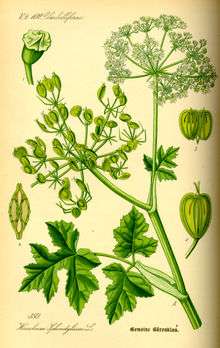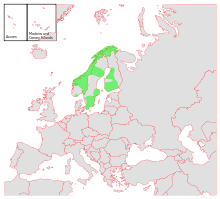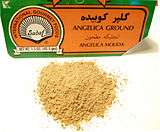Heracleum persicum
| Golpar | |
|---|---|
 | |
| Flower and leaf | |
| Scientific classification | |
| Kingdom: | Plantae |
| (unranked): | Angiosperms |
| (unranked): | Eudicots |
| (unranked): | Asterids |
| Order: | Apiales |
| Family: | Apiaceae |
| Genus: | Heracleum |
| Species: | H. persicum |
| Binomial name | |
| Heracleum persicum Desf. ex Fisch. | |

Heracleum persicum, commonly known as Persian hogweed or golpar (Persian: گلپر ), is a flowering plant in the family Apiaceae, native to Iran. It grows wild in humid mountainous regions in Iran, as well in some adjacent areas. Having been introduced in the 1830s, it is now very common in northern Norway, where it is known as the Tromsø palm.[1] The plant has also been spotted in Sweden. [2]
Uses
Food uses
The seeds are used as a spice in Persian cooking. The very thin, small seedpods are aromatic and slightly bitter. They are usually sold in powdered form and are often erroneously sold as "angelica seeds". The powder is sprinkled over broad beans, lentils and other legumes, and potatoes. Golpar is also used in soups and stews. It is often used sprinkled over pomegranate arils.[3] Golpar is also mixed with vinegar into which lettuce leaves are dipped before eating.
Golpar can be used in small amounts (1 or 2 tsp per pound) when cooking beans to reduce the effect of gas in the digestive tract associated with consuming beans.[4]

In Persian cuisine, the petals are used in the spice mixture advieh to flavor rice dishes, as well as in chicken and bean dishes.
The tender leaves and leaf stalks are also pickled (known as golpar toraei, Persian: گلپر تورایی).
See also
- Heracleum, the genus
- Other Europe invasive species Heracleum mantegazzianum and Heracleum sosnowskyi
- Native Europe hog weeds Heracleum sphondylium and Heracleum sibiricum (Heracleum sphondylium subsp. sibiricum)
- Species that can be mistaken for tall invasive hogweeds wild parsnip, garden angelica, wild angelica
References
- ↑ Straumsheim Grønli, Kristin (July 10, 2006), Bjørnekjeks tar kvelertak på naturen (Hogweed takes stranglehold on nature), retrieved September 12, 2011
- ↑ "Heracleum mantegazzianum, Heracleum sosnowskyi and Heracleum persicum". EPPO Bulletin. 39 (3): 489–499. 2009. doi:10.1111/j.1365-2338.2009.02313.x.
- ↑ Fujimori, Sachi (December 12, 2013). "Get cooking with pomegranates, the super fruit that's in season". NorthJersey.com. Retrieved December 31, 2013.
- ↑ Gas in the Digestive Tract
External links
- Analysis of the Oil of Heracleum persicum L. (seeds and stems)
- Heracleum persicum, Heracleum glabrescens (Persian)
- Sajjadi, S. E.; Noroozi, P. (2007). "Isolation and identification of xanthotoxin (8-methoxypsoralen) from the fruits of Heracleum persicum Desf. ex Fischer". Research in Pharmaceutical Sciences. April 2007 (2): 13–16. Retrieved 15 June 2016.